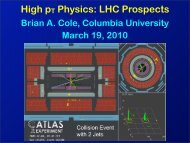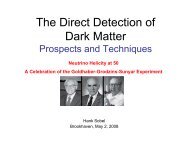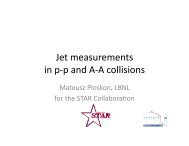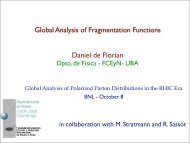One flavor QCD Abstract - BNL theory groups - Brookhaven National ...
One flavor QCD Abstract - BNL theory groups - Brookhaven National ...
One flavor QCD Abstract - BNL theory groups - Brookhaven National ...
Create successful ePaper yourself
Turn your PDF publications into a flip-book with our unique Google optimized e-Paper software.
of source terms is the famous “‘t Hooft vertex.” [31, 32] While it is correct that instantons do drop<br />
out of Z, they survive in correlation functions.<br />
While these issues are well understood theoretically, they can raise potential difficulties for<br />
numerical simulations. The usual procedure generates gauge configurations weighted as in the<br />
partition function. For a small quark mass, topologically non-trivial configurations will be suppressed.<br />
But in these configurations, large correlations can appear due to instanton effects. This<br />
combination of small weights with large correlations can give rise to large statistical errors, thus<br />
complicating small mass extrapolations. The problem will be particularly severe for quantities<br />
dominated by anomaly effects, such as the η ′ mass. A possible strategy to alleviate this effect<br />
is to generate configurations with a modified weight, perhaps along the lines of multi-canonical<br />
algorithms.[33]<br />
In our case of the one <strong>flavor</strong> <strong>theory</strong>, the ’t Hooft vertex is a quadratic form in the fermion<br />
sources. This will give a finite contribution to the condensate 〈ψψ〉 that is continuous in the mass<br />
as the mass passes through zero. Note that unlike the jump generated from complex eigenvalues<br />
discussed in the previous section, this contribution remains even at finite volume. As the volume<br />
goes to infinity it is still only the one instanton sector that contributes since all instantons far from<br />
the source ψψ get suppressed by the mass factor.<br />
Indeed, the ’t Hooft vertex represents a non-perturbative additive shift to the quark mass [34].<br />
As discussed in the next section, the size of this shift generally depends on scale and regulator<br />
details. Even with the Ginsparg-Wilson condition, the lattice Dirac operator is not unique, and<br />
there is no proof that two different forms have to give the same continuum limit for vanishing<br />
quark mass. Because of this, the concept of a single massless quark is not physical [3], invalidating<br />
one popular proposed solution to the strong CP problem. This ambiguity has been noted for heavy<br />
quarks in a more perturbative context [35] and is often referred to as the “renormalon” problem.<br />
VI.<br />
THE RENORMALIZATION GROUP<br />
In previous sections we discussed the quark mass as a simple parameter without really defining<br />
it precisely. Because of confinement, quarks are not free particles and the usual definition of mass<br />
via particles propagating over long distances does not apply. Furthermore, as we are dealing with<br />
a quantum field <strong>theory</strong>, all bare parameters are divergent and need renormalization. In this section<br />
we use renormalization group methods to accomplish this, giving a precise definition to a quark<br />
18






